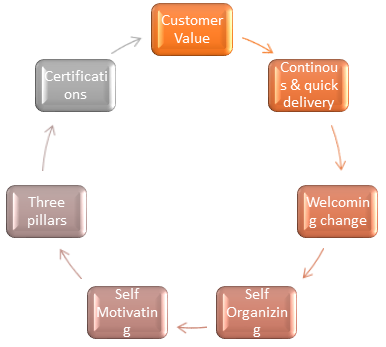Agile is hot in the market and so are the career opportunities in agile. As it becomes more and more important to understand and work in agile environment, the basics of agile and understanding of it has also become important. It will be very difficult for an individual to start working in a completely different environment if agile if basic know how is not gained.
These basics will act as triggers to start the career move towards agile or Scrum. Scrum is mentioned as it’s the most used form of agile in organization and it is expected from aspirant, moving towards agile, to have basic understanding of agile and Scrum.
Basics of Agile
Agile has some basic aspects which are now expected in almost all kind of project execution. Knowledge of these aspects helps agile teams and team members in their transition from traditional ways of working to agile way of working.
Customer Value
Customer value delivery is the most important aspect of agile. The focus has shifted from “how much code is developed” to “How much value is produced for client”. The features/requirements which are most important for client are focused in initial iteration cycles of the product and this priority can be virtually changed at any point of time. Understanding this aspect is nothing less than a paradigm shift for anyone but required to be understood.
Continuous & quick delivery
In agile, development, testing and deployment happens in every iteration which makes the delivery in chucks but quickly. These iterations happens one after another which makes it continuous. Agile delivery has to be continuous yet quick which is completely opposite to how work happens in waterfall. Delivery is at the end only once. This understanding is a must to adapt to agile environment. People moving to agile as to perform iteration after iterations, that’s the reason agile teams are different.
Welcoming change
This is one aspect of agile which make agile a delight for customers and also helps customer value delivery. Change is inevitable but procedure to tackle it in traditional way and agile way is completely different. Where traditionally changes and change requests are considered as extra work, in agile its part and parcel of work. Customer can prioritize, add or delete any features in the backlog. This paradigm shift of discouraging change to welcoming change is something agile team and aspirants of agile career has to understand and be ready with.
Self-Organizing & Self-Motivating
Another blow for Project Managers, in agile, there is no central controlling authority. Complete no to managers, only leaders and that too servant leaders. Team itself is the super power. This is very difficult to understand and implement practically.
Maximum friction/challenge is faced among team members on this aspect of agile. Teams and its members are expected to self-organize their work and also self-motivate themselves. Team as one entity is considered for outside world whereas internally team talk to each other very closely to self-organize and self-motivate. There is no reporting to manager. Team will report to team.
This sometime looks easy to agile aspirants that we will be controlling everything but the agile practices exposes the team members if s/he taking advantage of any situation. So never try to move towards agile as career thinking this is an easy bit to do full control is in team’s hand. This illusion has made many aspirants had very tough time in agile teams.
Three Pillars
Agile and scrum believes or based on three pillars of empirical process control i.e. Transparency, Inspection & Adaptation. Agile believes in doing work in small chunks, getting it inspected internally as well as by customer, then adapting the shortcoming or new features.
While doing this, teams will work in a complete transparent manner. Everything is visible and shared with client. Demonstrations happen after every iteration which act as inspection. After demonstration agile team note the feedback and do retrospective of the iteration which is completed.
This retrospective act as adaptation. While running the iteration and doing all these meetings, the mantra team follows is be transparent. All the information, metrics, burndowns, project progress is displayed openly. Customer is part of the team and through demonstrations aware of the status and happenings in a very transparent manner. Nothing is hidden, neither to management nor to client. Knowing these three pillars is as important as other aspects. Aspirants building their career in agile has to be well versed with these three pillars.
Certifications
Last but not the least, certifications. Transitions are not always within organization. To prepare oneself for outside market, one has to showcase the knowledge in a trustworthy manner. This is done by certifications. Agile certifications helps in multiple ways, it enhances knowledge, give assurance to recruiting organization as well as within organization, helps in getting future ready, enhances networking among agile community. All these facets act as catalyst to make one ready for its career move in agile.
- ULTIMATE GUIDE for Preparing PMP Certification Exam
- Self Study Training – Project Management Professional (PMP) Certification
Conclusion
Career transition from one form of working still to another form of working style is not easy. More you are prepared more you will enjoy it. The transition will become very smooth with the knowledge of basic aspects of agile. It’s highly recommended for aspirants planning or building their career in agile, to do preparation on these aspects in terms of knowledge and certifications. This will boost their aspirations and future goals and will make them future ready.
- What are Scrum roles and why it’s needed? - August 12, 2017
- Stakeholder Analysis – Is it required? - July 28, 2017
- Project Manager – An integrator, how? - July 28, 2017
- Different PMI Certifications – Which one to choose? - July 28, 2017
- What is the importance of Change Management in Project Management? - June 23, 2017
- What’s important to know to build a career in Agile? - June 23, 2017
- Agile Basics, Manifesto & Principles - June 23, 2017
- Scrum – Is it mandatory to learn in today’s IT market? - June 2, 2017



